Introduction
Atmospheric pressure is one of the most basic variables used to describe the state of the atmosphere and is commonly reported in weather observations. Unlike temperature and relative humidity, changes in atmospheric pressure are not as readily sensed by people. However, variations of pressure across the Earth are associated with pressure centers (either high-pressure centers or low-pressure centers) that cause the wind to blow and can bring important weather changes. Density, which is directly related to pressure, is a property of the atmosphere, which can be used by pilots to help determine how their aircraft will perform at various altitudes.
This chapter discusses atmospheric pressure, how it is measured, and how it varies across the Earth. This chapter also covers the altimeter, which is a pressure sensor used by pilots to determine altitude. Finally, density will be discussed, along with its relationship to density altitude.
Atmospheric Pressure
The atoms and molecules that make up the various layers in the atmosphere are always moving in random directions. Despite their tiny size, when they strike a surface, they exert pressure.
Each molecule is too small to feel and only exerts a tiny bit of pressure. However, when adding up all the pressures from the large number of molecules that strike a surface each moment, the total pressure is considerable. This is air pressure. As the density of the air increases, the number of strikes per unit of time and area also increases.
Since molecules move in all directions, they even exert air pressure upwards as they smash into objects from underneath. Air pressure is exerted in all directions.
Atmospheric pressure is the force per unit area exerted by the weight of the atmosphere. Since air is not solid, it cannot be weighed with conventional scales. Yet, three centuries ago, Evangelista Torricelli proved he could weigh the atmosphere by balancing it against a column of mercury. He actually measured pressure, converting it directly to weight.

Figure . Air Has Weight
Barometer
The instrument Torricelli designed to measure pressure was called a barometer. The aneroid barometer is the type most commonly used by meteorologists and the aviation community.
Essential features of an aneroid barometer are a flexible metal cell and the registering mechanism. Air is taken out of the cell to create a partial vacuum. The cell contracts or expands as pressure changes. One end of the cell is fixed, while the other end moves the registering mechanism. The coupling mechanism magnifies the movement of the cell driving an indicator hand along a scale graduated in pressure units.

Figure . Aneroid Barometer
Atmospheric Pressure Units
Atmospheric pressure is expressed in many ways throughout the world (see Table 8-1). Meteorologists worldwide have long measured atmospheric pressure in millibars (mb or mbar), which denote pressure as a force per square centimeter. However, after the introduction of the International System of Units (SI) in 1960, the hectopascal (hPa) was adopted by most countries and is used in the METAR/SPECI code first developed in 1968. Many meteorologists prefer to use the term they learned during their education and work experience. Therefore, some continue to use the term “millibars,” while others use “hectopascal” (which are equivalent). The unit inch of mercury (inHg or Hg) is still used in the United States for altimetry.
| Units of Pressure | Standard Atmosphere Value at Sea Level | Common Use |
| Hectopascals (hPa) | 1013.2 hPa | METAR/SPECI |
| Millibars (mb or mbar) | 1013.2 mb | U.S. Weather Charts |
| Inches of mercury (inHg or Hg) | 29.92 inHg | U.S. Aviation |
| Pounds per square inch (psi) | 14.7 psi | U.S. Engineering |
Station Pressure
The pressure measured at an airport is called station pressure, or the actual pressure at field elevation. Pressure is lower at higher altitudes. Therefore, airports with higher field elevations usually have lower pressure than airports with lower field elevations. For instance, station pressure at Denver is less than at New Orleans.
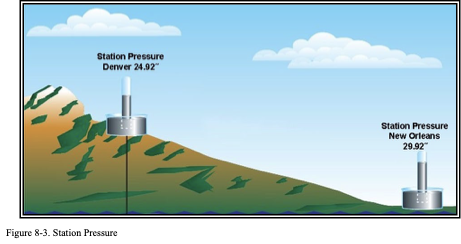
The next few sections will examine some factors that influence pressure.
Pressure Variation
Atmospheric pressure varies with altitude and the temperature of the air, as well as with other minor influences, such as water vapor.
Pressure Changes with Altitude
As a person moves upward through the atmosphere, the weight of the air above the person decreases. If a person carries a barometer, then they can measure a decrease in pressure as the weight of the air above them decreases. Figure hows the pressure decrease with height in the standard atmosphere.
The standard altitudes in are based on standard temperatures. In the real atmosphere, temperatures are seldom standard, so temperature’s effects on pressure will be explored in the following section.
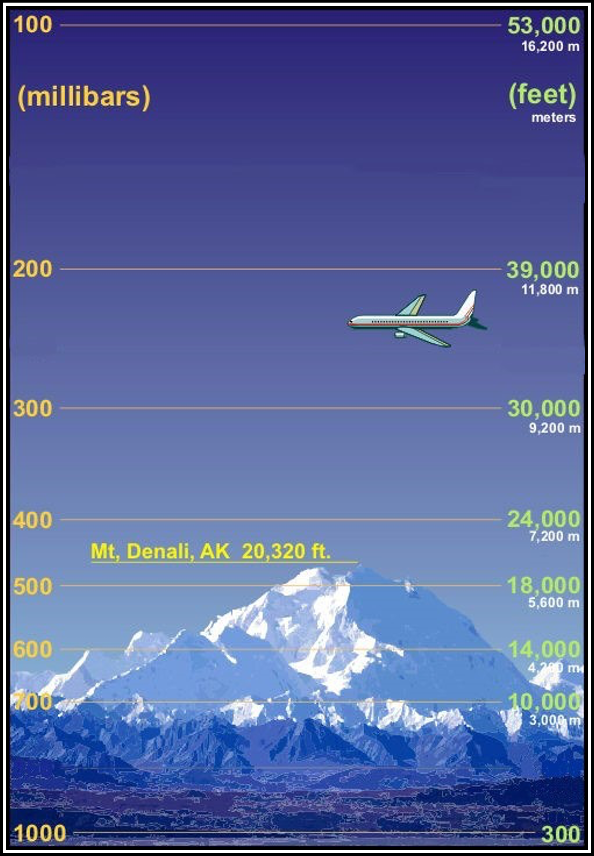
Figure . Air Pressure in the Standard Atmosphere
Temperature’s Effects on Pressure
Like most substances, air expands as it becomes warmer and contracts as it cools. Figure 8-5 shows three columns of air: one colder than standard, one with standard temperature, and one warmer than standard. Pressure is equal at the bottom and top of each column. Vertical expansion of the warm column has made it taller than the column at standard temperature. Contraction of the cold column has made it shorter than the standard column. Since the total pressure decrease is the same in each column, the rate of decrease of pressure with height in warm air is less than standard, while the rate of decrease in pressure with height in cold air is greater than standard.
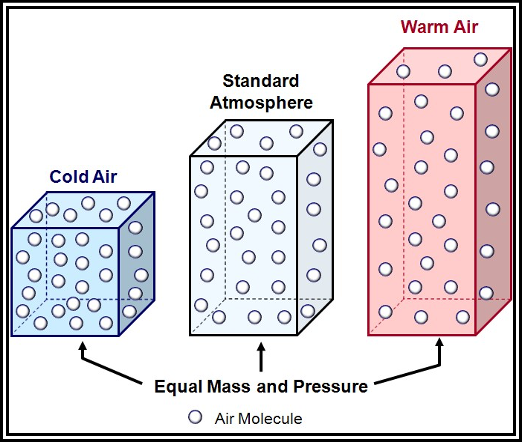
Figure . Temperature’s Effect on Pressure
Sea Level Pressure
Since pressure varies greatly with altitude, people cannot readily compare station pressures between stations at different altitudes. To make them comparable, they are adjusted to some common level. Mean sea level (MSL) is the most useful common reference. In Figure, pressure measured at a station at a 5,000-ft elevation is 25 inHg; pressure increases about 1 inHg for each 1,000 ft, or a total of 5 inHg. Sea level pressure is approximately 25 + 5, or 30 inHg.
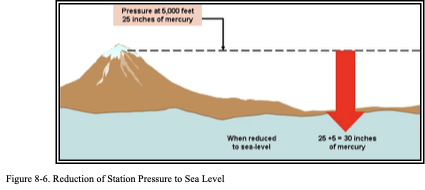
Sea level pressure is typically displayed on surface weather charts. Pressure continually changes across the Earth, so a sequence of surface charts must be viewed to follow these changing pressures.
Density
Density is the ratio of any quantity to the volume or area it occupies. Atmospheric density is defined as ratio of the mass (or weight) of the air to the volume occupied by it, usually expressed in kilograms per cubic meter.
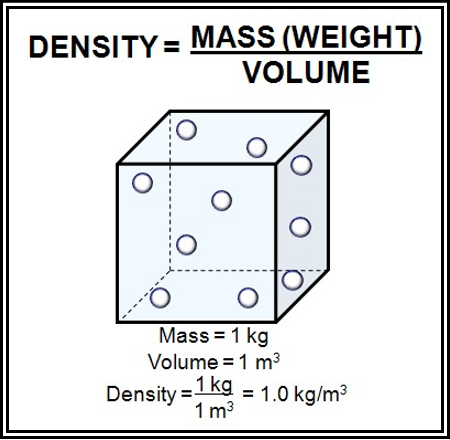
Figure . Density is Mass (Weight) per Volume
Volume’s Effects on Density
The density of an air parcel varies inversely with its volume. Assuming equal mass, an air parcel with a higher density has a smaller volume than an air parcel with a lower density .
The shorter parcel (i.e., the parcel with the smaller volume) has a higher density than the taller parcel, which contains the larger volume. This is due to the fact that the air molecules within the shorter parcel must be compressed within the smaller volume.
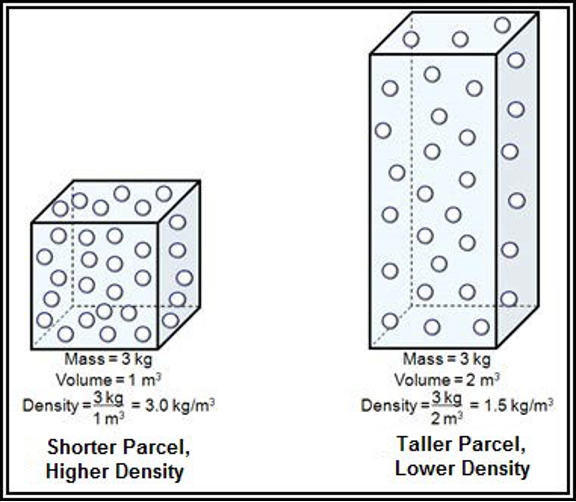
Figure . Volume’s Effects on Density
Changes in Density
In general, the density of an air parcel can be changed by changing its mass, pressure, or temperature. Boyle’s law says that the density of an ideal gas (ρ, the Greek letter rho) is given by:

Where M is the molar mass, P is the pressure, R is the universal gas constant, and T is the absolute temperature.
Density’s Effects on Pressure
Density is directly related to pressure. Assuming constant mass and temperature, an air parcel with a higher pressure is denser than an air parcel with a lower pressure.
As previously discussed, air pressure decreases with height in the atmosphere. Therefore, the density also decreases with height . In the atmosphere, pressure has the greatest effect on density in the vertical direction.
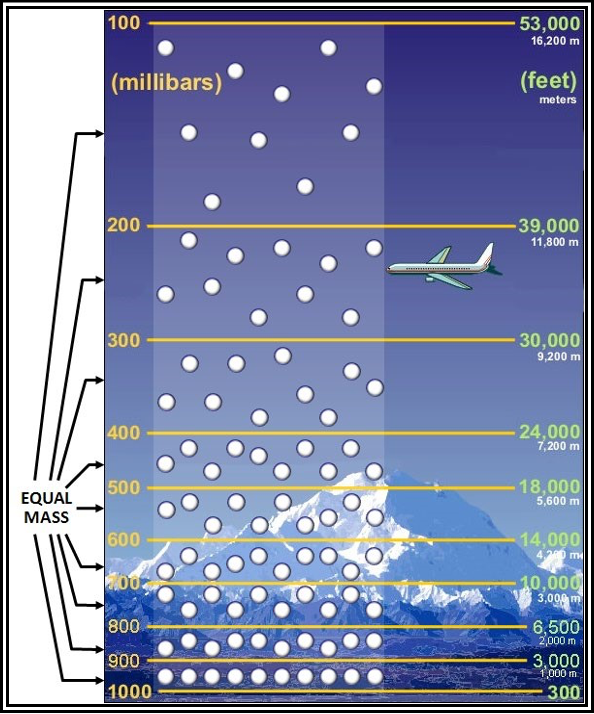
Figure . Pressure’s Effects on Density in the Atmosphere
Temperature’s Effects on Density
Density is inversely related to temperature. Assuming constant mass and pressure, an air parcel with a higher temperature is less dense than an air parcel with a lower temperature . This is because the warmer air occupies a large volume.
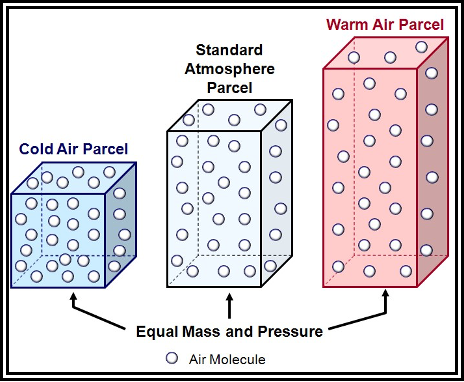
Figure . Temperature’s Effects on Density
In the atmosphere, temperature has the most effect on density in the horizontal direction; that is, with horizontal changes of location (e.g., New York City versus Miami), temperature has the greatest effect on density.
Water Vapor’s Effects on Density
Density of an air parcel is inversely related to its quantity of water vapor. Assuming constant pressure, temperature, and volume, air with a greater amount of water vapor is less dense than air with a lesser amount of water vapor. This is because dry air molecules have a larger mass (weight) than water vapor molecules, and density is directly related to mass .
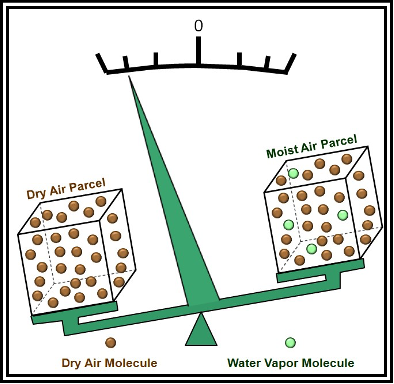
Figure . Water Vapor’s Effects on Density
Altimetry
The altimeter is essentially an aneroid barometer. The difference is the scale. The altimeter is graduated to read increments of altitude rather than units of pressure. The standard for graduating the altimeter is the standard atmosphere.
Altitude
Altitude seems like a simple term; it means the vertical elevation of an object above the surface of the Earth. However, in aviation, it can have many meanings.
True Altitude
Since existing conditions in a real atmosphere are seldom standard, altitude indications on the altimeter are seldom actual or true altitudes. True altitude is the actual vertical distance above MSL. If an altimeter does not indicate true altitude, what does it indicate?
Indicated Altitude
Figure 8-10 shows the effect of mean temperature on the thickness of three columns of air. Pressures are equal at the bottoms and tops of the three layers. Since an altimeter is essentially an aneroid barometer, altitude indicated by the altimeter at the top of each column would be the same. To see this effect more clearly, . In the warm air column, a pilot would fly at an altitude that is higher than the indicated altitude. In the cold air column, the pilot would fly at an altitude lower than the indicated altitude.
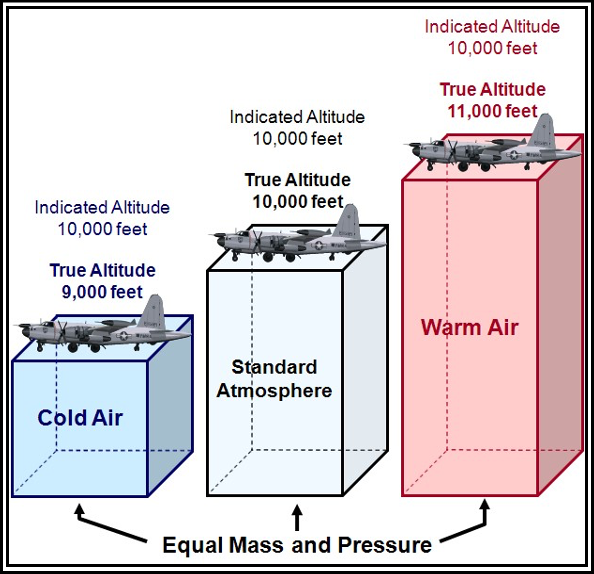
Figure . True Versus Indicated Altitude
Height indicated on the altimeter also changes with changes in surface pressure. A movable scale on the altimeter permits the pilot to adjust for surface pressure, but the pilot has no means of adjusting the altimeter for mean temperature of the column of air below. Indicated altitude is the altitude above MSL indicated on the altimeter when set at the local altimeter setting. But what is altimeter setting?
Altimeter Setting
Since the altitude scale is adjustable, a pilot can set the altimeter to read true altitude at some specified height. Takeoff and landing are the most critical phases of flight; therefore, airport elevation is the most desirable altitude for a true reading of the altimeter. The altimeter setting is the value to which the scale of the pressure altimeter is set so the altimeter indicates true altitude at field elevation.
To ensure the altimeter reading is compatible with altimeter readings of other aircraft in the vicinity, a pilot should ensure the altimeter setting is current. The pilot should adjust it frequently while in flight, according to the nearest surface weather reporting station. Figure 8-13 shows the trouble a pilot can encounter if not vigilant in adjusting the altimeter during flight. As the pilot flies from high pressure to low pressure, the plane is lower than the altimeter indicates.
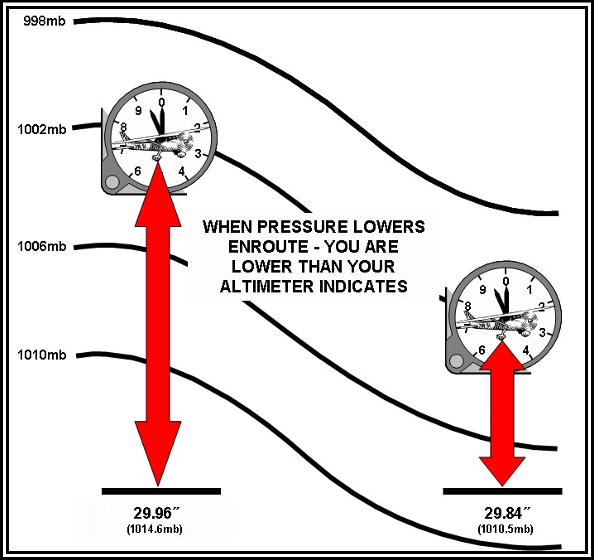
Figure . Pressure Change’s Effects on Altimeter Readings
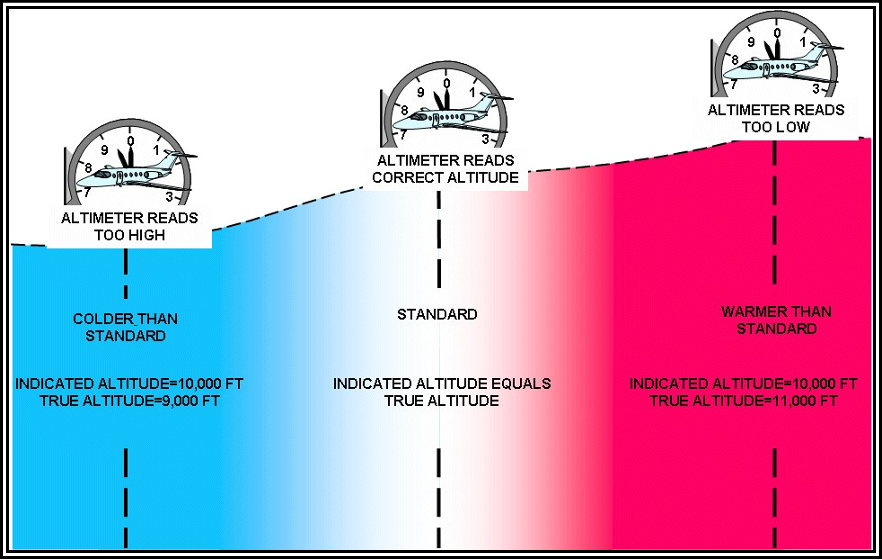
Figure . Temperature Change’s Effects on Altimeter Readings
Figure 8-14 shows that as a pilot flies from warm to cold air, the altimeter reads too high—the pilot is lower than the altimeter indicates. Over flat terrain, this lower-than-true reading is no great problem; other aircraft in the vicinity are also flying indicated rather than true altitude, and everyone’s altimeter readings are compatible. If flying in cold weather over mountainous areas, however, a pilot needs to take this difference between indicated and true altitude into account. The pilot needs to know that the true altitude assures clearance of terrain, and compute a correction to indicated altitude.
Corrected (Approximately True) Altitude
If a pilot could always determine the mean temperature of a column of air between the aircraft and the surface, flight computers would be designed to use this mean temperature in computing true altitude. However, the only guide a pilot has to temperature below is free air temperature at the pilot’s altitude. Therefore, the flight computer uses outside air temperature (OAT) to correct indicated altitude to approximately true altitude. The corrected (approximately true) altitude is indicated altitude corrected for the temperature of the air column below the aircraft, the correction being based on the estimated deviation of the existing temperature from standard atmosphere temperature. It is a close approximation to true altitude and is labeled true altitude on flight computers. It is close enough to true altitude to be used for terrain clearance, provided the pilot has the altimeter set to the value reported from a nearby reporting station.
Pressure Altitude
In the standard atmosphere, sea level pressure is 29.92 inHg (1013.2 mb). Pressure decreases at a fixed rate upward through the standard atmosphere. Therefore, in the standard atmosphere, a given pressure exists at any specified altitude. Pressure altitude is the altitude (above MSL) shown by the altimeter when set to 29.92 inHg. In other words, it is the altitude associated with a specific pressure measured by the static port when the altimeter is set to 29.92. Since pressure is the same everywhere regardless of the specific pressure altitude, a constant-pressure surface defines a constant-pressure altitude. When a pilot flies a constant-pressure altitude, the pilot is flying a constant-pressure surface.
As discussed earlier, constant-pressure surfaces have different heights across them. Therefore, when flying at a specific pressure altitude (i.e., constant-pressure surface) a pilot’s true altitude will change with distance. However, since pressure altitudes are flown at or above FL180 (in the United States), a pilot will almost always be above the highest terrain features.
Density Altitude
Density altitude is the pressure altitude corrected for temperature deviations from the standard atmosphere. Density altitude bears the same relation to pressure altitude as true altitude does to indicated altitude.
Density altitude is indirectly related to atmospheric density; as air density increases, the density altitude decreases, and conversely, as air density decreases, the density altitude increases. Airports with higher field elevations (e.g., Denver) have lower pressure, lower density, and, therefore, higher density altitudes than airports with lower field elevations (e.g., New Orleans).
Density altitude equals field elevation during standard atmospheric conditions, but conditions are rarely standard. Density altitude is higher (lower) than standard at airports that report lower (higher) than standard pressures (e.g., 29.92 inHg) and/or higher (lower)-than-standard temperatures. Temperature is the most important factor, since temperature has the greatest effect on density horizontally in the atmosphere. On hot days, the air becomes less dense, causing high density altitudes. On cold days, the air is denser, causing lower density altitudes. Dewpoint (water vapor) is also a contributing factor, but its effects are generally negligible.
Density altitude is an index to aircraft performance. Higher density altitude decreases aircraft performance. Lower density altitude increases aircraft performance. High density altitude is a hazard, since it reduces aircraftperformance in the following three ways:
- It reduces power because the engine takes in less air to support combustion.
- It reduces thrust because there is less air for the propeller to work with, or a jet has less mass of gases to force out of the exhaust.
- It reduces lift because the light air exerts less force on the airfoils.
A pilot cannot detect the effect of high density altitude on the airspeed indicator. The aircraft lifts off, climbs, cruises, glides, and lands at the prescribed indicated airspeeds; but at a specified indicated airspeed, the pilot’s true airspeed and groundspeed increase proportionally as density altitude becomes higher. The net results are that high density altitude lengthens a pilot’s takeoff and landing rolls and reduces the rate of climb. Before lift-off, the plane must attain a faster groundspeed, and, therefore, needs more runway; and the reduced power and thrust add a need for still more runway. The plane lands at a faster groundspeed and, therefore, needs more room to stop. At a prescribed indicated airspeed, it is flying at a faster true airspeed, and, therefore, covers more distance in a given time, which means climbing at a shallower angle. Adding to this are the problems of reduced power and rate of climb. Figure shows the effect of density altitude on takeoff distance and rate of climb.
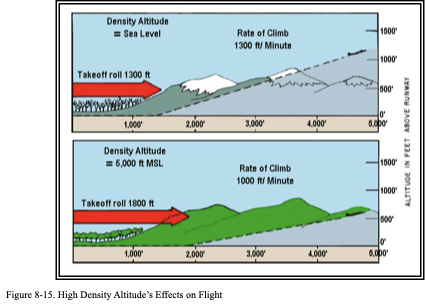
High density altitude also can be a problem at cruising altitude. When air temperature is higher (warmer) than standard atmosphere, the higher density altitude lowers the service ceiling. For example, if temperature at a pressure altitude of 10,000 ft is 20 °C, density altitude is 12,700 ft. A pilot’s aircraft will perform as though it were at 12,700 ft indicated with a normal temperature of -8 °C. To compute density altitude, a pilot can set the altimeter to 29.92 in (1,013.2 mb), read the pressure altitude from the altimeter, obtain the OAT, and then use a flight computer to compute density altitude..





